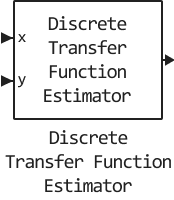Discrete Transfer Function Estimator With Magnitude
Computation of the transfer function estimation in the frequency domain.
blockType: DiscreteTransferFunctionEstimatorWithMagnitude
|
Path in the library: |
Description
The Discrete Transfer Function Estimator With Magnitude block estimates the transfer function of a system in the frequency domain using the averaged modified Welch periodogram method.
The block divides the input data into overlapping segments. The length of the data segment and the amount of data overlap can be set using the parameters set in the block dialogue box. The block sampling rate is equal to . - sampling interval of the block input parameters.
The block first applies the window function to the two input signals x and y, and then scales them by the window power. The block performs a Fast Fourier Transform (FFT) on each signal, calling them X and Y. The block calculates , which is the square of the FFT, X. The block then calculates , which is the product of X by the conjugate value of Y. The estimate of the output transfer function, H, is calculated by dividing by .
Parameters
Window length source - window length source
Same as input frame length (by default)
Source of the window length value. You can set this parameter to a value:
-
Same as input frame length- the window length is set by the input frame size.
Window overlap (%) - window overlap (%)
0 (by default) | non-negative scalar
The percentage of overlap between consecutive windows of data as a scalar in the range [0,100). The value by default is 0.
Averaging method - averaging method
Running (by default).
Specify the averaging method:
-
Running- the block calculates an equal weighted average of the number of spectrum averages specified by the Number of spectral averages parameter.
Number of spectral averages - number of spectral averages
1 (by default) | positive integer
Set the number of spectral averages. The Discrete Transfer Function Estimator With Magnitude block calculates the current estimate by averaging the last estimates. - number of spectral averages. This can be any positive integer scalar, the value by default is 1.
Dependencies
This parameter is used when the Averaging method parameter is set to Running.
FFT length source - FFT length source
Auto (by default) | Property
Specify the source of FFT length value.
-
Auto- FFT length is equal to the input frame size. -
Property- FFT length is defined by FFT length parameter.
FFT length - FFT length
128 (by default) | positive integer.
Specify the FFT length that the Discrete Transfer Function Estimator With Magnitude block uses to calculate spectral estimates. This can be any positive integer scalar, the value by default is 128.
Window function - window function
Hann (by default).
Set the window function for the Discrete Transfer Function Estimator With Magnitude block. Possible value:
-
Hann(By default).
Frequency range* - frequency range
`One-sided (By default)
Set the frequency range of the transfer function estimation.
-
onesided- The Discrete Transfer Function Estimator With Magnitude block calculates the one-way transfer function of the actual input signals *x* and *y*.
Output magnitude squared coherence estimate - output magnitude squared coherence estimate
off (by default) | on
Select this checkbox to calculate and output the coherence squared estimate using the averaged modified Welch periodogram method. The coherence squared estimate indicates how well two input signals match each other at each frequency.
Algorithms
*Method of averaged modified Welch periodograms.
Set two input signals, and :
-
Multiply the input parameters by the window function and scale the result by the window power.
-
Perform FFT on the signals and .
-
Compute the current power spectral density estimates, , , and the current crossed power spectral density (PSD) estimate, , by taking the moving average of the last number N vectors , and , respectively:
The transfer function estimate is calculated by dividing by .
The coherence square of is determined by the following equation:
